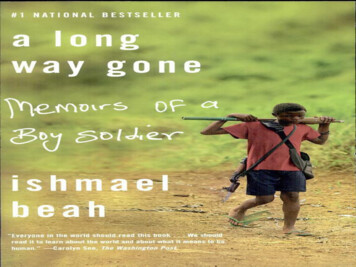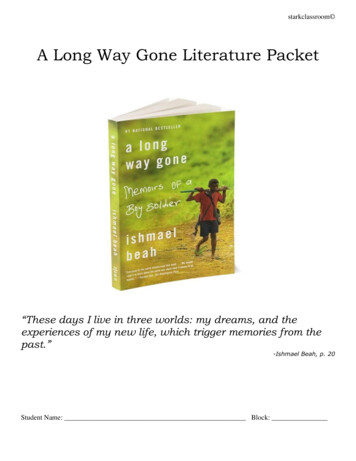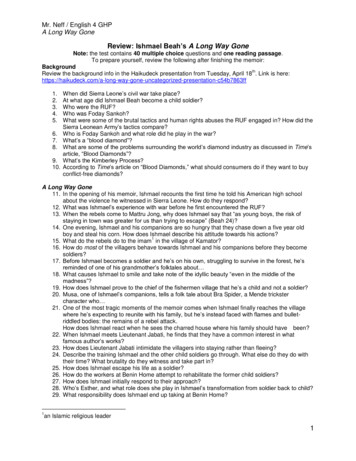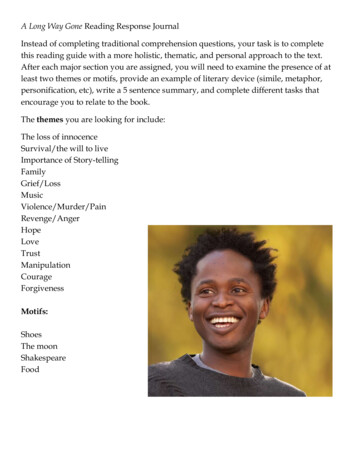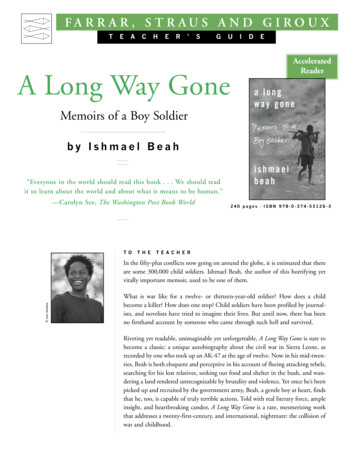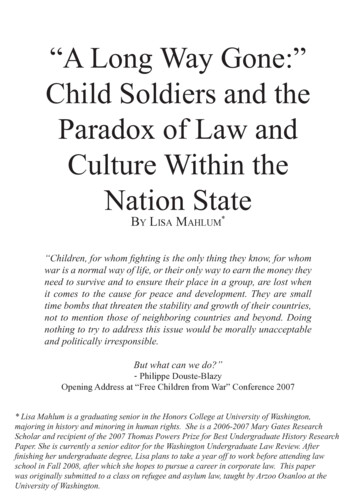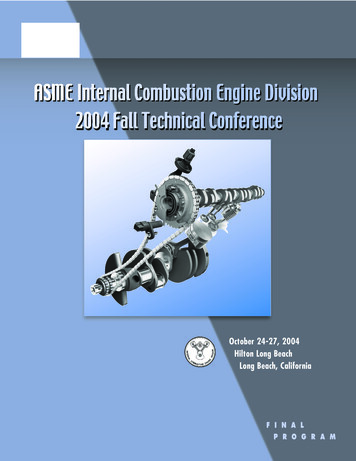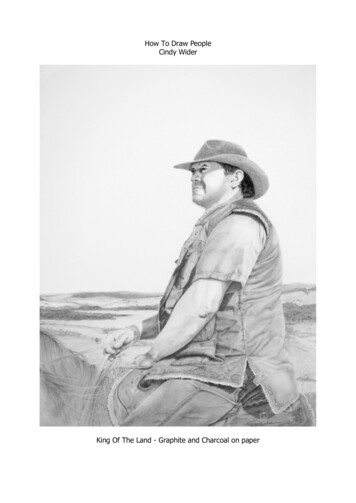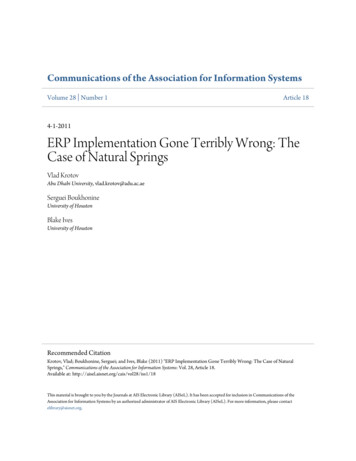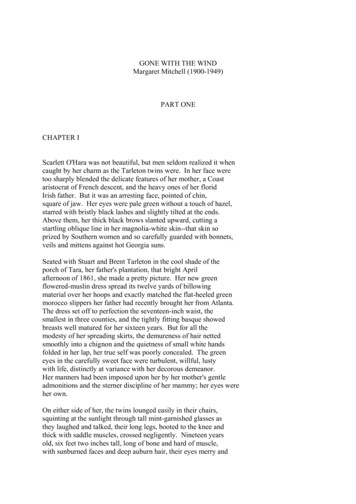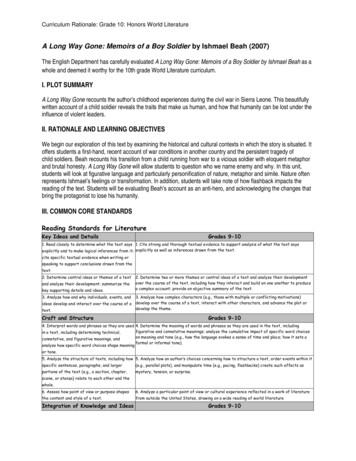
Transcription
Curriculum Rationale: Grade 10: Honors World LiteratureA Long Way Gone: Memoirs of a Boy Soldier by Ishmael Beah (2007)The English Department has carefully evaluated A Long Way Gone: Memoirs of a Boy Soldier by Ishmael Beah as awhole and deemed it worthy for the 10th grade World Literature curriculum.I. PLOT SUMMARYA Long Way Gone recounts the author’s childhood experiences during the civil war in Sierra Leone. This beautifullywritten account of a child soldier reveals the traits that make us human, and how that humanity can be lost under theinfluence of violent leaders.II. RATIONALE AND LEARNING OBJECTIVESWe begin our exploration of this text by examining the historical and cultural contexts in which the story is situated. Itoffers students a first-hand, recent account of war conditions in another country and the persistent tragedy ofchild soldiers. Beah recounts his transition from a child running from war to a vicious soldier with eloquent metaphorand brutal honesty. A Long Way Gone will allow students to question who we name enemy and why. In this unit,students will look at figurative language and particularly personification of nature, metaphor and simile. Nature oftenrepresents Ishmael’s feelings or transformation. In addition, students will take note of how flashback impacts thereading of the text. Students will be evaluating Beah’s account as an anti-hero, and acknowledging the changes thatbring the protagonist to lose his humanity.III. COMMON CORE STANDARDSReading Standards for LiteratureKey Ideas and DetailsGrades 9-101. Read closely to determine what the text says 1. Cite strong and thorough textual evidence to support analysis of what the text saysexplicitly and to make logical inferences from it; explicitly as well as inferences drawn from the text.cite specific textual evidence when writing orspeaking to support conclusions drawn from thetext.2. Determine central ideas or themes of a textand analyze their development; summarize thekey supporting details and ideas.3. Analyze how and why individuals, events, andideas develop and interact over the course of atext.2. Determine two or more themes or central ideas of a text and analyze their developmentover the course of the text, including how they interact and build on one another to producea complex account; provide an objective summary of the text.3. Analyze how complex characters (e.g., those with multiple or conflicting motivations)develop over the course of a text, interact with other characters, and advance the plot ordevelop the theme.Craft and StructureGrades 9-104. Interpret words and phrases as they are used 4. Determine the meaning of words and phrases as they are used in the text, includingfigurative and connotative meanings; analyze the cumulative impact of specific word choicesin a text, including determining technical,on meaning and tone (e.g., how the language evokes a sense of time and place; how it sets aconnotative, and figurative meanings, andformal or informal tone).analyze how specific word choices shape meaningor tone.5. Analyze the structure of texts, including how 5. Analyze how an author’s choices concerning how to structure a text, order events within itspecific sentences, paragraphs, and larger(e.g., parallel plots), and manipulate time (e.g., pacing, flashbacks) create such effects asportions of the text (e.g., a section, chapter,mystery, tension, or surprise.scene, or stanza) relate to each other and thewhole.6. Assess how point of view or purpose shapes6. Analyze a particular point of view or cultural experience reflected in a work of literaturethe content and style of a text.from outside the United States, drawing on a wide reading of world literatureIntegration of Knowledge and IdeasGrades 9-10
Curriculum Rationale: Grade 10: World Literature9. Analyze how two or more texts address9. Analyze how an author draws on and transforms source material in a specific work (e.g.,similar themes or topics in order to buildhow Shakespeare treats a theme or topic from Ovid or the Bible or how a later author drawsknowledge or to compare the approaches theon a play by Shakespeare).authors take.Range of Reading and Level of TextGrades 9-10Complexity10. Read and comprehend complex literary and10. By the end of grade 9, read and comprehend literature, including stories, dramas, andinformational texts independently andpoems, in the grades 9-10 text complexity band proficiently, with scaffolding as needed atproficiently.the high end of the range.By the end of grade 10, read and comprehend literature, including stories, dramas, andpoems, at the high end of the grades 9-10 text complexity band independently andproficiently.By the end of grade 10, read and comprehend literature, including stories, dramas, andpoems, at the high end of the grades 9–10 text complexity band independently andproficiently.IV. ADDRESSING SENSITIVE SUBJECTSPossible sensitive topics contained in A Long Way Gone: Memoirs of a Boy Soldier by Ishmael Beah: violence, druguse, Post Traumatic Stress Disorder, language, and references to sexual violence.In the classroom, sensitive topics will be dealt with in a mature fashion, toward an understanding of why this materialis included in the memoir. The English department feels that the literary merit of the memoir more than compensatesfor the inclusion of this sensitive subject matter. The student is encouraged to feel comfortable in expressing his/herbeliefs and views openly within the classroom environment. If the student is uncomfortable at any time, the studentshould meet with the teacher to discuss his/her concerns.Adapted From: http://ttbyl.net/a-long-way-gone-by-ishmael-beah/
Curriculum Rationale: Grade 10: Honors World LiteratureAn Ordinary Man: An Autobiography of Paul Rusesabagina by: Tom Zoellner(2006)The English Department has carefully evaluated An Ordinary Man: An Autobiography of Paul Rusesabagina by: TomZoellner as a whole and deemed it worthy for the 10th grade World Literature curriculum.I. PLOT SUMMARYAn Ordinary Man recounts the life of Paul Rusesabagina As Rwanda was thrown into chaos during the 1994genocide. Rusesabagina, a hotel manager, turned the luxurious Hotel Milles Collines into a refuge for more than1,200 Tutsi and moderate Hutu refugees, while fending off their would-be killers with a combination of diplomacy anddeception. In An Ordinary Man, he tells the story of his childhood, retraces his accidental path to heroism, revisits the100 days in which he was the only thing standing between his “guests” and a hideous death, and recounts hissubsequent life as a refugee and activistII. RATIONALE AND LEARNING OBJECTIVESWe begin our exploration of this text by examining the historical and cultural contexts in which the story is situated. Itoffers students a first-hand, recent account of war conditions in another country and the persistent tragedy ofgenocide and discrimination. This book will be read in conjunction with activities in World History 10, where studentswill not only understand the historical and cultural implications of genocide, but will receive a clear testimony of theproceedings. Students will examine the language and cultural implications within the text, and will evaluateRusesabagina’s tale as it fits with the Hero’s Journey. Students will determine if Rusesabagina should be defined asa hero, or as An Ordinary Man, as he states.III. COMMON CORE STANDARDSReading Standards for LiteratureKey Ideas and DetailsGrades 9-101. Read closely to determine what the text says 1. Cite strong and thorough textual evidence to support analysis of what the text saysexplicitly and to make logical inferences from it; explicitly as well as inferences drawn from the text.cite specific textual evidence when writing orspeaking to support conclusions drawn from thetext.2. Determine central ideas or themes of a textand analyze their development; summarize thekey supporting details and ideas.3. Analyze how and why individuals, events, andideas develop and interact over the course of atext.2. Determine two or more themes or central ideas of a text and analyze their developmentover the course of the text, including how they interact and build on one another to producea complex account; provide an objective summary of the text.3. Analyze how complex characters (e.g., those with multiple or conflicting motivations)develop over the course of a text, interact with other characters, and advance the plot ordevelop the theme.Craft and StructureGrades 9-104. Interpret words and phrases as they are used 4. Determine the meaning of words and phrases as they are used in the text, includingfigurative and connotative meanings; analyze the cumulative impact of specific word choicesin a text, including determining technical,on meaning and tone (e.g., how the language evokes a sense of time and place; how it sets aconnotative, and figurative meanings, andformal or informal tone).analyze how specific word choices shape meaningor tone.5. Analyze the structure of texts, including how 5. Analyze how an author’s choices concerning how to structure a text, order events within itspecific sentences, paragraphs, and larger(e.g., parallel plots), and manipulate time (e.g., pacing, flashbacks) create such effects asportions of the text (e.g., a section, chapter,mystery, tension, or surprise.scene, or stanza) relate to each other and thewhole.
Curriculum Rationale: Grade 10: World Literature6. Assess how point of view or purpose shapes6. Analyze a particular point of view or cultural experience reflected in a work of literaturethe content and style of a text.from outside the United States, drawing on a wide reading of world literatureIntegration of Knowledge and IdeasGrades 9-109. Analyze how two or more texts address9. Analyze how an author draws on and transforms source material in a specific work (e.g.,similar themes or topics in order to buildhow Shakespeare treats a theme or topic from Ovid or the Bible or how a later author drawsknowledge or to compare the approaches theon a play by Shakespeare).authors take.Range of Reading and Level of TextGrades 9-10Complexity10. Read and comprehend complex literary and10. By the end of grade 9, read and comprehend literature, including stories, dramas, andinformational texts independently andpoems, in the grades 9-10 text complexity band proficiently, with scaffolding as needed atproficiently.the high end of the range.By the end of grade 10, read and comprehend literature, including stories, dramas, andpoems, at the high end of the grades 9-10 text complexity band independently andproficiently.By the end of grade 10, read and comprehend literature, including stories, dramas, andpoems, at the high end of the grades 9–10 text complexity band independently andproficiently.IV. ADDRESSING SENSITIVE SUBJECTSPossible sensitive topics contained in An Ordinary Man: An Autobiography of Paul Rusesabagina by: Tom Zoellnerviolence, language.In the classroom, sensitive topics will be dealt with in a mature fashion, toward an understanding of why this materialis included in the memoir. The English department feels that the literary merit of the autobiography more thancompensates for the inclusion of this sensitive subject matter. The student is encouraged to feel comfortable inexpressing his/her beliefs and views openly within the classroom environment. If the student is uncomfortable at anytime, the student should meet with the teacher to discuss his/her concerns.
Curriculum Rationale: Grade 10: Honors World LiteratureAngela’s Ashes: A Memoir by Frank McCourt (1996)The English Department has carefully evaluated Angela’s Ashes: A Memoir as a whole and deemed it worthy for the10th grade World Literature curriculum.I. PLOT SUMMARYFrank McCourt’s, Angela’s Ashes, is a poignant retelling of life during the Depression, specifically for Irishimmigrants. McCourt is faced with varying challenges involving poverty, discrimination in America and Ireland, andhis father’s alcoholism. McCourt’s memoir allows the reader to critically evaluate the form of memoir and the conceptof memory. The student will study the narrative voice and analyze its role in the craft of memoir.II. RATIONALE AND LEARNING OBJECTIVESWe begin our exploration of this text by examining the historical and cultural contexts in which the story is situated.Angela’s Ashes, a coming of age story, anchors the memoir unit, where students study the genre and craft of memoirand finally draft memoirs of their own. We will consider the roles of memory, truth, and fact in autobiographicalwriting, as well as the literary techniques writers employ to shape their own stories. Students will closely readexcerpts of Angela’s Ashes to analyze narrative voice, especially perspective, tone, and mood. We will also examineMcCourt’s development of themes including but not limited to poverty/hunger, alcoholism, discrimination, andfaith/spirituality.III. COMMON CORE STANDARDSReading Standards for LiteratureKey Ideas and DetailsGrades 9-101. Read closely to determine what the text says 1. Cite strong and thorough textual evidence to support analysis of what the text saysexplicitly and to make logical inferences from it; explicitly as well as inferences drawn from the text.cite specific textual evidence when writing orspeaking to support conclusions drawn from thetext.2. Determine central ideas or themes of a textand analyze their development; summarize thekey supporting details and ideas.3. Analyze how and why individuals, events, andideas develop and interact over the course of atext.2. Determine two or more themes or central ideas of a text and analyze their developmentover the course of the text, including how they interact and build on one another to producea complex account; provide an objective summary of the text.3. Analyze how complex characters (e.g., those with multiple or conflicting motivations)develop over the course of a text, interact with other characters, and advance the plot ordevelop the theme.Craft and StructureGrades 9-104. Interpret words and phrases as they are used 4. Determine the meaning of words and phrases as they are used in the text, includingfigurative and connotative meanings; analyze the cumulative impact of specific word choicesin a text, including determining technical,on meaning and tone (e.g., how the language evokes a sense of time and place; how it sets aconnotative, and figurative meanings, andformal or informal tone).analyze how specific word choices shape meaningor tone.5. Analyze the structure of texts, including how 5. Analyze how an author’s choices concerning how to structure a text, order events within itspecific sentences, paragraphs, and larger(e.g., parallel plots), and manipulate time (e.g., pacing, flashbacks) create such effects asportions of the text (e.g., a section, chapter,mystery, tension, or surprise.scene, or stanza) relate to each other and thewhole.6. Assess how point of view or purpose shapes6. Analyze a particular point of view or cultural experience reflected in a work of literaturethe content and style of a text.from outside the United States, drawing on a wide reading of world literatureIntegration of Knowledge and IdeasGrades 9-10
Curriculum Rationale: Grade 10: World Literature9. Analyze how two or more texts address9. Analyze how an author draws on and transforms source material in a specific work (e.g.,similar themes or topics in order to buildhow Shakespeare treats a theme or topic from Ovid or the Bible or how a later author drawsknowledge or to compare the approaches theon a play by Shakespeare).authors take.Range of Reading and Level of TextGrades 9-10Complexity10. Read and comprehend complex literary and10. By the end of grade 9, read and comprehend literature, including stories, dramas, andinformational texts independently andpoems, in the grades 9-10 text complexity band proficiently, with scaffolding as needed atproficiently.the high end of the range.By the end of grade 10, read and comprehend literature, including stories, dramas, andpoems, at the high end of the grades 9-10 text complexity band independently andproficiently.By the end of grade 10, read and comprehend literature, including stories, dramas, andpoems, at the high end of the grades 9–10 text complexity band independently andproficiently.IV. ADDRESSING SENSITIVE SUBJECTSPossible sensitive topics contained in Angela’s Ashes: A Memoir: references to sexuality and profanity.In the classroom, sensitive topics will be dealt with in a mature fashion, toward an understanding of why this materialis included in the memoir. The English department feels that the literary merit of the memoir more than compensatesfor the inclusion of this sensitive subject matter. The student is encouraged to feel comfortable in expressing his/herbeliefs and views openly within the classroom environment. If the student is uncomfortable at any time, the studentshould meet with the teacher to discuss his/her concerns.
Curriculum Rationale: Grade 10: Honors World LiteraturePersepolis by Marjane Satrapi (2001)ANDFilm Adaptation. Vincent Paronnaud, Marjane Satrapi, 2007.The English Department has carefully evaluated both the text and film Persepolis a whole and deemed them worthyfor the 10th grade World Literature curriculum.I. PLOT SUMMARYMarjane Satrapi’s graphic novel, Persepolis, is an autobiographical account of life in Iran during the 1979 IranianRevolution. Satrapi recounts her life between the ages of nine and fourteen. Marji struggles with what she is beingtaught at home and what the government is imposing on her society and school. The student will examine thecomponents of the graphic novel genre and analyze how Satrapi uses it to present historical fact within literature,specifically examining the Iranian and Islamic revolutions. The student will also compare and contrast the written textwith the film.II. RATIONALE AND LEARNING OBJECTIVESThis unit is grounded in a study of the text’s cultural and historical contexts. Students conduct guided research aboutIran and its Islamic revolution that occurred in the late 1970s as they begin reading Satrapi’s memoir. This text drivesthe graphic novel unit in which students examine of the overlap/adaptation of conventional literary techniques ingraphic novels—a non-conventional genre which has received critical acclaim in academic/literary communities.Furthermore, students make connections between the graphic novel form and storyboarding as an important part offilmmaking when they view the film adaptation of the text.As Persepolis is a memoir, students draw on their knowledge from the previous unit (Angela’s Ashes) to considerhow memoir writers use theme, symbolism, voice, and plot structure in different forms to generate meaning andinfluence interpretation. Finally, students create their own graphic story to demonstrate comprehension of thelearning objectives in this unit.III. COMMON CORE STANDARDSReading Standards for LiteratureKey Ideas and DetailsGrades 9-101. Read closely to determine what the text says 1. Cite strong and thorough textual evidence to support analysis of what the text saysexplicitly and to make logical inferences from it; explicitly as well as inferences drawn from the text.cite specific textual evidence when writing orspeaking to support conclusions drawn from thetext.2. Determine central ideas or themes of a textand analyze their development; summarize thekey supporting details and ideas.3. Analyze how and why individuals, events, andideas develop and interact over the course of atext.Craft and Structure2. Determine two or more themes or central ideas of a text and analyze their developmentover the course of the text, including how they interact and build on one another to producea complex account; provide an objective summary of the text.3. Analyze how complex characters (e.g., those with multiple or conflicting motivations)develop over the course of a text, interact with other characters, and advance the plot ordevelop the theme.Grades 9-10
Curriculum Rationale: Grade 10: World Literature4. Interpret words and phrases as they are used 4. Determine the meaning of words and phrases as they are used in the text, includingfigurative and connotative meanings; analyze the cumulative impact of specific word choicesin a text, including determining technical,on meaning and tone (e.g., how the language evokes a sense of time and place; how it sets aconnotative, and figurative meanings, andformal or informal tone).analyze how specific word choices shape meaningor tone.5. Analyze the structure of texts, including how 5. Analyze how an author’s choices concerning how to structure a text, order events within itspecific sentences, paragraphs, and larger(e.g., parallel plots), and manipulate time (e.g., pacing, flashbacks) create such effects asportions of the text (e.g., a section, chapter,mystery, tension, or surprise.scene, or stanza) relate to each other and thewhole.6. Assess how point of view or purpose shapes6. Analyze a particular point of view or cultural experience reflected in a work of literaturethe content and style of a text.from outside the United States, drawing on a wide reading of world literatureIntegration of Knowledge and Ideas7. Integrate and evaluate content presented inGrades 9-107. Analyze the representation of a subject or a key scene in two different artistic mediums,diverse formats and media, including visually and including what is emphasized or absent in each treatment (e.g., Auden’s “Musée des Beauxquantitatively, as well as in words.Arts” and Breughel’s Landscape with the Fall of Icarus9. Analyze how two or more texts address9. Analyze how an author draws on and transforms source material in a specific work (e.g.,similar themes or topics in order to buildhow Shakespeare treats a theme or topic from Ovid or the Bible or how a later author drawsknowledge or to compare the approaches theon a play by Shakespeare).authors take.Range of Reading and Level of TextGrades 9-10Complexity10. Read and comprehend complex literary and10. By the end of grade 9, read and comprehend literature, including stories, dramas, andinformational texts independently andpoems, in the grades 9-10 text complexity band proficiently, with scaffolding as needed atproficiently.the high end of the range.By the end of grade 10, read and comprehend literature, including stories, dramas, andpoems, at the high end of the grades 9-10 text complexity band independently andproficiently.By the end of grade 10, read and comprehend literature, including stories, dramas, andpoems, at the high end of the grades 9–10 text complexity band independently andproficiently.IV. ADDRESSING SENSITIVE SUBJECTSPossible sensitive topics contained in Persepolis: profanity, violence, and brief sexual references.In the classroom, sensitive topics will be dealt with in a mature fashion, toward an understanding of why this materialis included in the graphic novel and its film adaptation. The English department feels that the literary merit of thegraphic novel and its film adaptation more than compensates for the inclusion of this sensitive subject matter. Thestudent is encouraged to feel comfortable in expressing his/her beliefs and views openly within the classroomenvironment. If the student is uncomfortable at any time, the student should meet with the teacher to discuss his/herconcerns.
Curriculum Rationale: Grade 10: Honors World LiteratureThe Joy Luck Club by Amy Tan (1989)The English Department has carefully evaluated The Joy Luck Club as a whole and deemed it worthy for the 10thgrade World Literature curriculum.I. PLOT SUMMARYAmy Tan’s The Joy Luck Club is a multi-generational story that follows the lives of four Chinese women and theirdaughters. The women gather to share stories about their childhoods, relationships, marriages, and immigration toAmerica. Tan’s novel challenges the reader to evaluate the differences in culture, religion, and societal andgenerational beliefs of differing time periods.II. RATIONALE AND LEARNING OBJECTIVESThis unit is grounded in a study of the text’s cultural and historical contexts. Specifically, students examine the natureof the immigration experience for Asian migrants entering the U.S., especially during the late 1800s and early 1900s(particularly those affected by the Chinese Exclusion Act). Students focus their analysis on Tan’s development ofthematic tension in the four fable sections and sixteen interlocking vignettes that make up the book. Students areasked to consider whether or not the themes of ignorance v. knowledge, loss v. gain, rebellion v. obedience, and badluck v. good intentions are resolved in the text, and what factors promote or prevent resolution of this thematictension. In addition, students will critically analyze the text’s complex structure and characterization, as well asidentify how the author uses literary techniques including point of view and symbolism to illustrate thematic tension.III. COMMON CORE STANDARDSReading Standards for LiteratureKey Ideas and DetailsGrades 9-101. Read closely to determine what the text says 1. Cite strong and thorough textual evidence to support analysis of what the text saysexplicitly and to make logical inferences from it; explicitly as well as inferences drawn from the text.cite specific textual evidence when writing orspeaking to support conclusions drawn from thetext.2. Determine central ideas or themes of a textand analyze their development; summarize thekey supporting details and ideas.3. Analyze how and why individuals, events, andideas develop and interact over the course of atext.2. Determine two or more themes or central ideas of a text and analyze their developmentover the course of the text, including how they interact and build on one another to producea complex account; provide an objective summary of the text.3. Analyze how complex characters (e.g., those with multiple or conflicting motivations)develop over the course of a text, interact with other characters, and advance the plot ordevelop the theme.Craft and StructureGrades 9-104. Interpret words and phrases as they are used 4. Determine the meaning of words and phrases as they are used in the text, includingfigurative and connotative meanings; analyze the cumulative impact of specific word choicesin a text, including determining technical,on meaning and tone (e.g., how the language evokes a sense of time and place; how it sets aconnotative, and figurative meanings, andformal or informal tone).analyze how specific word choices shape meaningor tone.5. Analyze the structure of texts, including how 5. Analyze how an author’s choices concerning how to structure a text, order events within itspecific sentences, paragraphs, and larger(e.g., parallel plots), and manipulate time (e.g., pacing, flashbacks) create such effects asportions of the text (e.g., a section, chapter,mystery, tension, or surprise.scene, or stanza) relate to each other and thewhole.6. Assess how point of view or purpose shapes6. Analyze a particular point of view or cultural experience reflected in a work of literaturethe content and style of a text.from outside the United States, drawing on a wide reading of world literature
Curriculum Rationale: Grade 10: World LiteratureIntegration of Knowledge and Ideas7. Integrate and evaluate content presented inGrades 9-107. Analyze the representation of a subject or a key scene in two different artistic mediums,diverse formats and media, including visually and including what is emphasized or absent in each treatment (e.g., Auden’s “Musée des Beauxquantitatively, as well as in words.Arts” and Breughel’s Landscape with the Fall of IcarusRange of Reading and Level of TextGrades 9-10Complexity10. Read and comprehend complex literary and10. By the end of grade 9, read and comprehend literature, including stories, dramas, andinformational texts independently andpoems, in the grades 9-10 text complexity band proficiently, with scaffolding as needed atproficiently.the high end of the range.By the end of grade 10, read and comprehend literature, including stories, dramas, andpoems, at the high end of the grades 9-10 text complexity band independently andproficiently.By the end of grade 10, read and comprehend literature, including stories, dramas, andpoems, at the high end of the grades 9–10 text complexity band independently andproficiently.IV. ADDRESSING SENSITIVE SUBJECTSPossible sensitive topics contained in The Joy Luck Club: violence, brief references to sex, and profanity.In the classroom, sensitive topics will be dealt with in a mature fashion, toward an understanding of why this materialis included in the novel. The English department feels that the literary merit of the novel more than compensates forthe inclusion of this sensitive subject matter. The student is encouraged to feel comfortable in expressing his/herbeliefs and views openly within the classroom environment. If the student is uncomfortable at any time, the studentshould meet with the teacher to discuss his/her concerns.
Curriculum Rationale: Grade 10: Honors World LiteratureThe Kite Runner by Khaled Hossieni (2003)ANDFilm Adaptation. Mark Forster, 2007.The English Department has carefully evaluated The Kite Runner and its film adaptation—each as a whole, anddeemed them worthy for the 10th grade World Literature curriculum. However, the suggestive scene from chapterseven of the novel will be omitted for the purpose of class screening.I. PLOT SUMMARYKhaled Hossieni’s The Kite Runner is a story about two young boys growing up in Afghanistan during the Sovietoccupation of 1978. Through a series of flashbacks interwoven with present day, Hossieni tells the story of Amir andhis servant/best friend Hassan and how their choices have devastating effects on both of their lives. Hossienipresents a world under Taliban rule, examples of class division, racism, and the power of choice.II
A Long Way Gone will allow students to question who we name enemy and why. In this unit, students will look at figurative language and particularly personification of nature, metaphor and simile. Nature often represents Ishmael’s feelings or transformation. In addit
